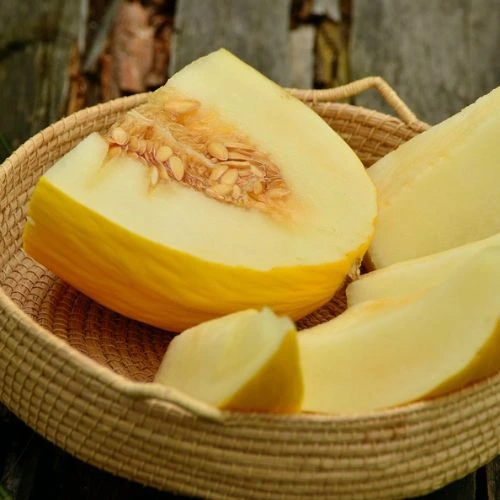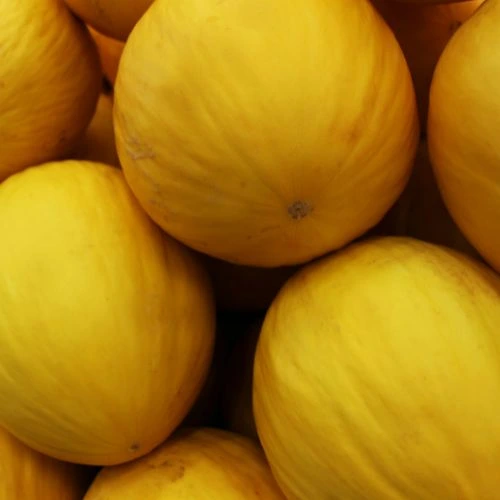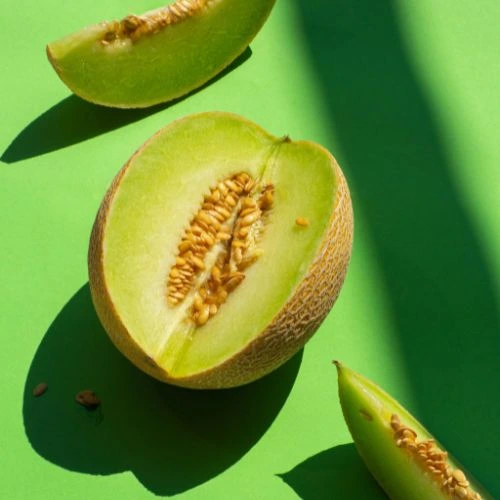Have you ever wondered what makes casaba melon so special? This often-overlooked fruit stands out with its distinct taste, firm texture, and striking appearance. If you’re tired of the same old cantaloupe and honeydew, casaba melon offers a fresh twist on the melon experience. Packed with hydration and essential nutrients, it’s a delicious and healthy option to add to your fruit basket.
Unlike its more famous melon cousins, casaba melon’s thick, wrinkled rind hides a mildly sweet, refreshing flavor that’s perfect for summer days. But there’s more to this melon than just good taste. Have you ever considered growing your own? It’s easier than you might think. With the right soil, sunlight, and a little patience, you’ll be harvesting ripe, golden-yellow casaba melons right from your backyard.
In this guide, we’ll cover everything you need to know about casaba melon — from its fascinating origins to expert growing tips. Whether you’re a gardener looking for a new challenge or a foodie searching for a fresh recipe idea, this blog has something for everyone. We’ll walk you through planting, caring for, and harvesting casaba melons, plus show you how to enjoy them in salads, smoothies, and more. By the end, you’ll have all the knowledge you need to become a casaba melon connoisseur.
So, if you’re ready to try something new and exciting, stick around. This flavorful fruit might just become your next obsession. Let’s dive into the world of casaba melon and discover why it’s a must-have for your kitchen and garden.
In This Article
| Common Name | Casaba Melon |
| Botanical Name | Cucumis melo var. inodorus |
| Family | Cucurbitaceae |
| Plant Type | Annual Vine |
| Mature Size | Vines can grow up to 10 feet long; fruits are 6-8 inches in diameter |
| Bloom Time | Summer |
| Toxicity | Non-toxic to humans and pets |
| Sun Exposure | Full Sun (6-8 hours daily) |
| Soil Type | Well-drained, sandy, nutrient-rich soil |
| Soil pH | 6.0 to 6.8 |
| Flower Color | Yellow |
| Hardiness Zones | Grown as an annual, suitable for USDA zones 4-11 |
| Native Area | Persia (modern-day Iran) |
What is Casaba Melon?
Overview :
Casaba melon is a unique and flavorful fruit that stands out from other melons like cantaloupe and honeydew. Its distinct taste, which is mildly sweet with a hint of spiciness, makes it a sought-after option for those seeking variety in their fruit selection. The texture is smooth and firm, offering a satisfying bite that’s perfect for fresh snacking or adding to fruit salads. Unlike other melons, its thick, wrinkled rind adds a rustic, natural charm.
Did you know that casaba melon has a rich history that dates back to ancient Persia? Over time, it made its way to the United States, where it’s now grown in warm, dry climates. This melon’s ability to thrive in hot weather has made it a favorite for home gardeners looking for a resilient, heat-tolerant crop.
What Makes Casaba Melon Unique?
- Distinct flavor: Sweet, mild, and slightly spicy.
- Unique texture: Firm yet tender, ideal for fresh eating or mixing into fruit platters.
- Hard, wrinkled rind: Unlike the smooth skin of cantaloupe or honeydew, casaba’s skin is tough and rustic-looking, providing added protection.
The History and Origins of Casaba Melon
- Originated in ancient Persia, now Iran.
- Brought to the U.S. and grown in warm, arid climates.
Nutritional Value
- Packed with hydration: Casaba melon has a high water content, making it a refreshing summer treat.
- Rich in vitamins and minerals: Provides a good source of vitamin C and essential antioxidants that support immune health.
- Low in calories: A guilt-free, nutritious option for healthy snacking.
By now, you’re probably wondering how this melon compares to its popular cousins like honeydew and cantaloupe. If you’ve ever asked yourself, “What is a casaba melon and how is it different?” — you’re not alone. The main difference lies in its unique flavor, thicker skin, and firm texture. While honeydew and cantaloupe have softer, juicier flesh, casaba’s firmer consistency gives it an edge in versatility for recipes and storage.
This introductory section not only showcases the unique aspects of casaba melon but also builds anticipation for what’s to come. From growing tips to tasty recipes, there’s much more to explore about this underappreciated melon.
How to Grow Casaba Melon in Your Garden
Preparing Your Garden for Casaba Melon Have you ever thought about growing this unique fruit in your own garden? If so, you’re in for a rewarding experience! Casaba melon is a hardy fruit that thrives in warm, dry climates, making it a perfect choice for gardeners in regions with plenty of sunshine. Here’s how to set up your garden for success.
Climate and Soil Requirements
To give your casaba melon the best start, you’ll need to ensure the right climate and soil conditions. Here’s what you’ll need to do:
- Climate: Casaba melons love warmth and grow best in temperatures between 70°F and 90°F. Make sure to wait until after the final frost before planting.
- Soil: They prefer well-drained, sandy soil with a pH between 6.0 and 6.8. If your soil is too compact, consider mixing in organic matter like compost to boost drainage and nutrients.
- Sunlight: Full sun is essential for healthy growth. Choose a location where your melons will receive at least 6-8 hours of sunlight daily.
Best Time to Plant :
Timing is everything when it comes to growing casaba melons. Here’s a quick breakdown:
- When to Plant: Start planting seeds outdoors after the last frost of the season. For those in cooler climates, consider starting seeds indoors 3-4 weeks before the last frost date.
- Seasonal Consideration: In most U.S. regions, planting from late spring to early summer is ideal, allowing the melons ample time to mature.
Planting Casaba Melon Seeds
Once you’ve prepared your garden, it’s time to plant your casaba melon seeds. Follow these step-by-step instructions to ensure healthy growth:
How to Plant Casaba Melon Seeds
- Prepare the Soil: Till the soil to loosen it up and remove rocks, weeds, and debris.
- Seed Depth: Plant seeds 1 inch deep, spacing them 24-36 inches apart to allow for vine growth.
- Watering: Water the seeds immediately after planting, keeping the soil consistently moist but not waterlogged.
- Mulching: Add a layer of mulch to retain moisture, reduce weeds, and regulate soil temperature.
Companion Plants for Casaba Melon
Planting companion crops alongside casaba melon can promote healthy growth and prevent pests. Consider these beneficial companions:
- Corn: Acts as a windbreak and provides partial shade.
- Beans: Improves soil nitrogen levels, giving melons a nutrient boost.
- Marigolds: Naturally repel pests like aphids and beetles.
By following these simple steps, you’ll be well on your way to a successful harvest of fresh, delicious fruits. Stay tuned for the next section, where we’ll cover tips on how to care for your growing plants to ensure they thrive.
Harvesting and Storing Casaba Melon
How to Know When Casaba Melon is Ripe
Wondering how to tell when your fruit is ripe and ready to pick? Knowing the right time to harvest is crucial for flavor and freshness. Here’s how to tell:
Signs of Ripeness
- Color Change: The skin changes from bright green to a rich golden-yellow.
- Texture: The surface becomes slightly soft but still firm to the touch.
- Aroma: A sweet, fruity aroma near the stem end is a good indicator of ripeness.
Mistakes to Avoid When Harvesting
- Picking Too Early: Harvesting too soon can result in a bland, underdeveloped flavor.
- Overripe Melons: Waiting too long can lead to over-ripeness, resulting in mushy texture.
- Rough Handling: Avoid bruising the melon during harvest, as this can shorten its shelf life.
Harvesting Techniques
- Use a Sharp Knife: Cut the melon from the vine, leaving a small portion of the stem attached.
- Handle with Care: Gently place the harvested melon in a container or basket.
How to Store Casaba Melon
- Whole Melons: Store at room temperature for up to 2 weeks.
- Cut Melons: Wrap in plastic and refrigerate for 3-5 days.
Culinary Uses :
Casaba melon’s sweet yet subtle flavor makes it a versatile ingredient in the kitchen. From refreshing summer salads to thirst-quenching smoothies, there are countless ways to enjoy it. Here are a few popular uses:
Fresh Eating: Slice it up and enjoy it on its own as a hydrating snack.
Salads: Pair it with greens, feta cheese, and a tangy vinaigrette for a refreshing salad.
Smoothies: Blend it with other fruits for a naturally sweet, healthy smoothie.
Common Problems :
Growing casaba melons can be incredibly rewarding, but like any crop, they come with a few challenges. Have you ever wondered why your melon vines aren’t thriving as expected? It’s a common experience for gardeners, but the good news is, most issues have simple fixes.
Why Aren’t My Casaba Melons Growing?
If your casaba melons aren’t growing well, you might be dealing with one of these issues:
- Poor Soil Quality: Casaba melons prefer well-drained, sandy soil. If the soil is too dense or lacks nutrients, growth will be stunted. Solution: Add organic compost to boost soil health.
- Insufficient Sunlight: Melons need at least 6-8 hours of full sun daily. Lack of sun means slow growth and small fruit. Solution: Relocate your plants to a sunnier spot or trim any overhead foliage that may be blocking sunlight.
- Improper Watering: Overwatering or underwatering can both cause problems. Casaba melons need consistently moist soil, but too much water can cause root rot. Solution: Water deeply but infrequently and consider using mulch to regulate moisture.
Pest and Disease Challenges
Even the healthiest melon vines are not immune to pests and diseases. Here’s how to spot and solve these problems before they ruin your harvest.
Most Common Pests
- Aphids: These tiny, sap-sucking insects cause curling leaves and stunt plant growth. Solution: Spray with a natural insecticidal soap or introduce ladybugs to your garden.
- Cucumber Beetles: These beetles chew on leaves and flowers, damaging the entire plant. Solution: Use yellow sticky traps or apply neem oil to repel them.
- Spider Mites: Tiny mites that leave behind yellow spots on leaves. Solution: Spray plants with a strong stream of water or use neem oil for long-term protection.
How to Identify and Treat Diseases
- Powdery Mildew: This white, powder-like fungus grows on leaves, slowing down photosynthesis. Solution: Spray leaves with a mixture of water and baking soda, and ensure proper air circulation between plants.
- Fusarium Wilt: This soil-borne fungus causes leaves to wilt and die. Solution: Use crop rotation and plant resistant varieties. If infected, remove the plant to avoid spreading it to others.
- Downy Mildew: Yellow or brown spots on leaves may signal downy mildew. Solution: Increase air circulation and apply a fungicide at the first sign of infection.
By identifying these common issues early and following these simple solutions, you’ll be well on your way to growing healthy, vibrant fruits. Let me know if you’d like any edits or additions to this section.
FAQs
How Long Does it Take to Grow Casaba Melon?
Curious about how long it takes for a casaba melon to be ready for harvest? Typically, it takes about 90 to 110 days from planting to harvest. This timeline can vary slightly depending on weather conditions and the specific growing region. Ensuring the right temperature, sunlight, and watering schedule can speed up the growth process.
Can I Grow Casaba Melon in a Container or Pot?
Absolutely! While casaba melons are vine plants, they can be grown in large containers or pots. Here’s what you’ll need:
- Container Size: Choose a pot that holds at least 5 gallons of soil.
- Trellis Support: Since vines spread, a trellis can keep them upright and save space.
- Soil & Water: Use well-draining, nutrient-rich soil and ensure the pot has drainage holes. Water regularly, but avoid waterlogging.
This method is ideal for gardeners with limited space or those looking to grow melons on a balcony or patio.
Is Casaba Melon the Same as Honeydew or Cantaloupe?



Not quite! While they’re all melons, each one has a unique flavor and appearance. Here’s how casaba melon differs:
- Skin Texture: Casaba melons have a thick, wrinkled rind, while honeydew has smooth skin and cantaloupe has a rough, netted surface.
- Flavor: Casaba has a mild, slightly spicy flavor, unlike the sweetness of honeydew or the musky taste of cantaloupe.
- Flesh Color: While honeydew is light green and cantaloupe is orange, casaba’s flesh is pale white to yellow.
What’s the Best Way to Store a Cut Casaba Melon?
Once you’ve sliced into a casaba melon, proper storage is key to maintaining its freshness. Here’s how to do it:
- Wrap It: Cover the cut portions with plastic wrap or place them in an airtight container.
- Refrigerate: Store it in the fridge at a temperature of around 40°F (4°C).
- Use Quickly: Eat it within 3 to 5 days to enjoy the best flavor and texture.
Can You Eat the Seeds of a Casaba Melon?
Yes, you can! While most people discard casaba melon seeds, they’re completely edible. Here’s how to use them:
- Roast Them: Similar to pumpkin seeds, casaba melon seeds can be roasted for a crunchy, protein-packed snack.
- Compost Them: If you’re not interested in eating them, toss them into your compost pile to enrich your garden soil naturally.
If you plan to grow more melons, you can also save the seeds for planting next season. Just wash, dry, and store them in a cool, dry place.
This FAQ section aims to answer the most pressing questions readers have about casaba melon, offering practical tips and easy-to-follow guidance. Let me know if you’d like any adjustments or have specific questions to address in this section.
Conclusion
By now, you’ve discovered just how special casaba melon truly is. From its sweet yet subtly spicy flavor to its firm texture and rustic appearance, it’s clear that this melon is anything but ordinary. Whether you’re looking to add variety to your fruit bowl or grow something unique in your garden, casaba melon is a top contender.
Growing casaba melon at home may seem challenging at first, but with the right knowledge, it’s a rewarding experience. You’ve learned how to prepare the soil, plant the seeds, and care for your growing vines. When it’s time to harvest, you’ll be able to enjoy the satisfaction of picking fresh, golden-yellow melons straight from your garden.
But it doesn’t stop there. Casaba melon’s culinary versatility makes it an exciting addition to your kitchen. From refreshing fruit salads to smoothies and even creative desserts, the possibilities are endless. And don’t forget — those seeds you’d normally toss can be roasted for a healthy, crunchy snack!
If you’re still on the fence about growing casaba melon, ask yourself this: Why not try something new? With its unique flavor, stunning appearance, and health benefits, this fruit has all the makings of a garden and kitchen favorite. Take the plunge, give it a shot, and you might just find your new favorite fruit.
So, what’s next? Grab some casaba melon seeds, prepare your garden, and get ready for an exciting journey from seed to harvest. Your future self — and your taste buds — will thank you. If you’ve enjoyed this guide, be sure to check out our other gardening tips and recipes to keep your garden growing strong all season long.

